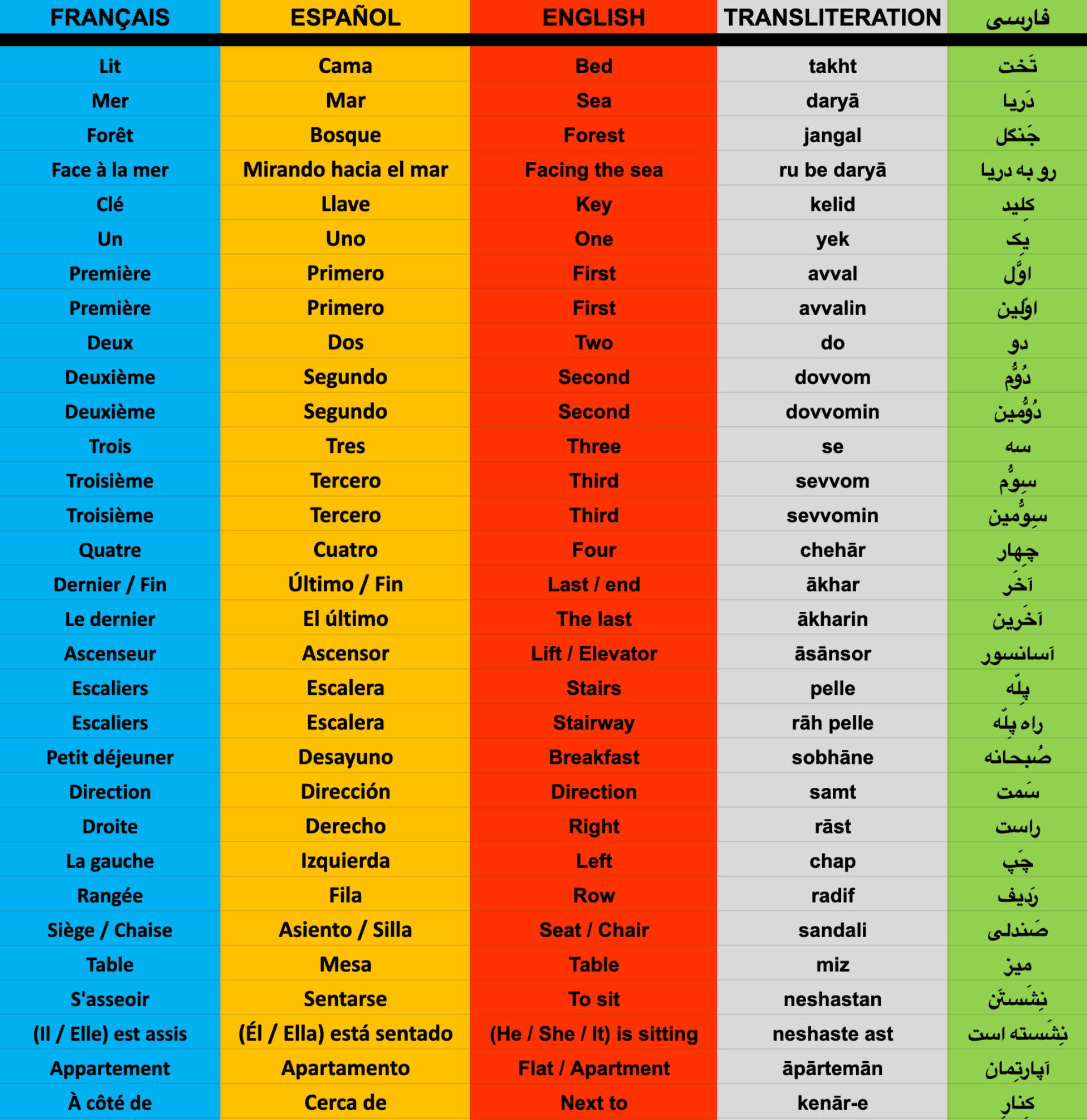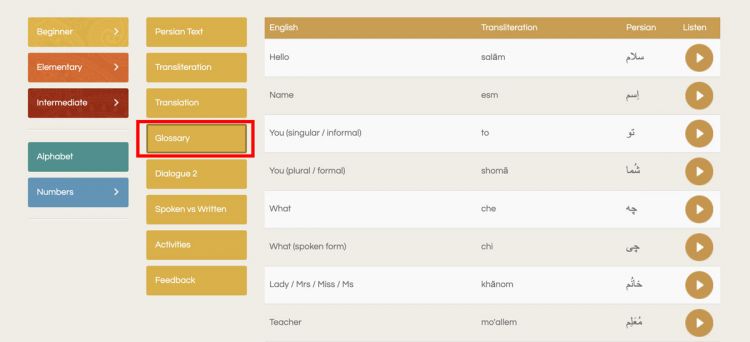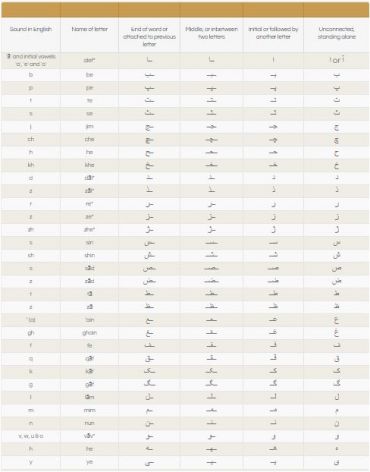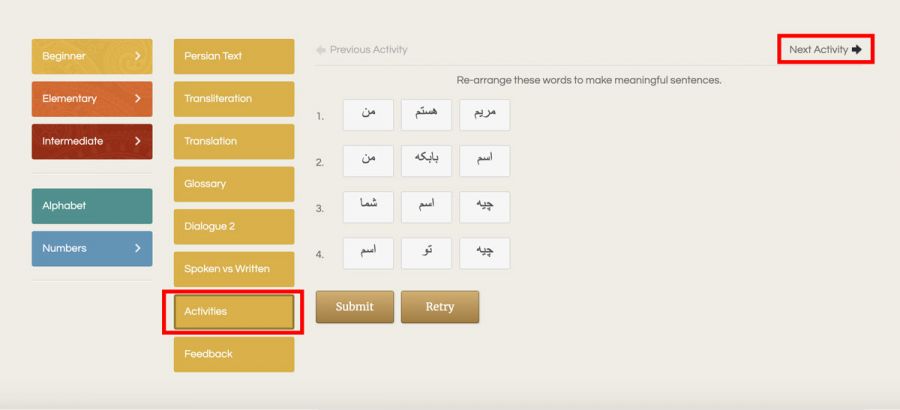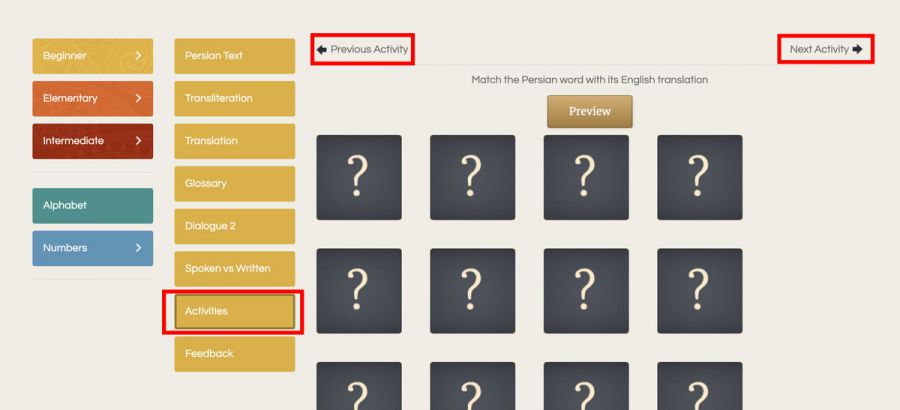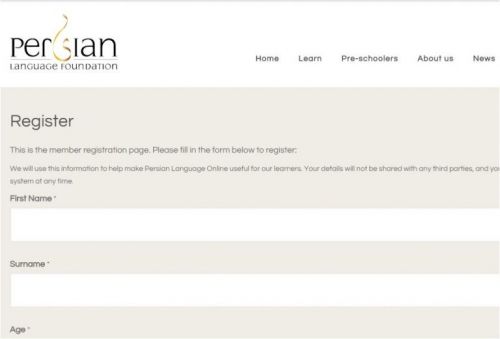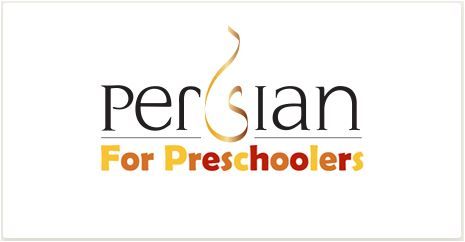
Project 6060 – Lesson 16
EN
FR
ES
FA
DIALOGUE 1
DIALOGUE 1
DIÁLOGO 1
مُکالِمه یِکُم
-
EN
Lesson 16
I’d like a double room
***
Transliteration of Dialogue 1
Bābak: bebakhshin ye otāq-e do takhte mikhām.
Paziresh: ru be daryā yā ru be jangal?
Bābak: ru be daryā lotfan.
Paziresh: lotfan in form-o por konin.
Bābak: befarmāyin.
Paziresh: lotfan pāsportetun-o bedin.
Bābak: befarmāyin.
Paziresh: in kelid. otāq-e chāhār sad-o do. tabaqe-ye chāhārom.
Bābak: āsānsor kojāst?
Paziresh: kenār-e rāh pelle.
Bābak: resturān kojāst?
Paziresh: resturān tabaqe-ye avvale. sobhune ham az sā’at-e haft tā dah-e sobhe.
Bābak: estakhr kojāst?
Paziresh: estakhr tabaqeye ākhare.Translation of Dialogue 1
Babak: Excuse me, I would like a double (/twin) room.
Receptionist: Facing the sea or facing the forest?
Babak: Facing the sea please.
Receptionist: Please fill in this form.
Babak: There you go.
Receptionist: Please give me your passport.
Babak: Here you are.
Receptionist: Here’s the key. It’s room 402. Fourth floor.
Babak: Where’s the lift?
Receptionist: Next to the stairway.
Babak: Where’s the restaurant?
Receptionist: The restaurant is on the first floor.
And breakfast is from seven until ten in the morning.
Babak: Where’s the pool?
Receptionist: The pool is on the top floor. -
FR
Leçon 16
Je voudrais une chambre double
***
Translitération de Dialogue 1
Bābak: bebakhshin ye otāq-e do takhte mikhām.
Paziresh: ru be daryā yā ru be jangal?
Bābak: ru be daryā lotfan.
Paziresh: lotfan in form-o por konin.
Bābak: befarmāyin.
Paziresh: lotfan pāsportetun-o bedin.
Bābak: befarmāyin.
Paziresh: in kelid. otāq-e chāhār sad-o do. tabaqe-ye chāhārom.
Bābak: āsānsor kojāst?
Paziresh: kenār-e rāh pelle.
Bābak: resturān kojāst?
Paziresh: resturān tabaqe-ye avvale. sobhune ham az sā’at-e haft tā dah-e sobhe.
Bābak: estakhr kojāst?
Paziresh: estakhr tabaqeye ākhare.Traduction de Dialogue 1
Coming soon -
ES
Lección 16
Quisiera un cuarto doble
***
Transcripción de Diálogo 1
Bābak: bebakhshin ye otāq-e do takhte mikhām.
Paziresh: ru be daryā yā ru be jangal?
Bābak: ru be daryā lotfan.
Paziresh: lotfan in form-o por konin.
Bābak: befarmāyin.
Paziresh: lotfan pāsportetun-o bedin.
Bābak: befarmāyin.
Paziresh: in kelid. otāq-e chāhār sad-o do. tabaqe-ye chāhārom.
Bābak: āsānsor kojāst?
Paziresh: kenār-e rāh pelle.
Bābak: resturān kojāst?
Paziresh: resturān tabaqe-ye avvale. sobhune ham az sā’at-e haft tā dah-e sobhe.
Bābak: estakhr kojāst?
Paziresh: estakhr tabaqeye ākhare.Traducción de Diálogo 1
Coming soon -
FA
درس شانزدهم
یه اتاق دو تخته می خوام
***
متن فارسی مُکالمه اوّل
بابک: ببخشین یه اتاق دو تخته می خوام.
پذیرش: رو به دریا یا رو به جنگل؟
بابک: رو به دریا لطفاً.
پذیرش: لطفاْ این فرمُ پر کنین.
بابک: بفرمایین.
پذیرش: لطفاْ پاسپورتتونُ بدین.
بابک: بفرمایین.
پذیرش: این کلید. اتاق ۴۰۲. طبقۀ چهارم.
بابک: آسانسور کجاست؟
پذیرش: کنار راه پلّه.
بابک: رستوران کجاست؟
پذیرش: رستوران طبقۀ اوّله. صبحونه هم از ساعت ۷ تا ۱۰ صبحه.
بابک: استخر کجاست؟
پذیرش: استخر طبقۀ آخره.
DIALOGUE 2
DIALOGUE 2
DIÁLOGO 2
مُکالِمه دُوُّم
-
EN
Transliteration of Dialogue 2
rāmin: sinā, khune-ye shomā kojāst?
sinā: khiyābun-e bahār, kuche-ye avval, dast-e rāst.
rāmin: kojā?
sinā: khiyābun-e bahār, avvalin kuche, samt-e rāst. Khune-ye shomā kojāst?
rāmin: meydun-e āzādi, khiyābun-e jāmi, āpārtemān-e lāle, tabaqe-ye dovvom.
sinā: tabaqe-ye chandom?
rāmin: tabaqe-ye dovvom.Translation of Dialogue 2
Ramin: Sina, where is your house?
Sina: First road on the right, off Bahar Street.
Ramin: Where?
Sina: The first road on the right hand side, off Bahar Street. Where’s your house?
Ramin: On the second floor of Lale Apartments, in Jami Street, off Azadi Square.
Sina: Which floor?
Ramin: The second floor.. -
FR
Translitération de Dialogue 2
rāmin: sinā, khune-ye shomā kojāst?
sinā: khiyābun-e bahār, kuche-ye avval, dast-e rāst.
rāmin: kojā?
sinā: khiyābun-e bahār, avvalin kuche, samt-e rāst. Khune-ye shomā kojāst?
rāmin: meydun-e āzādi, khiyābun-e jāmi, āpārtemān-e lāle, tabaqe-ye dovvom.
sinā: tabaqe-ye chandom?
rāmin: tabaqe-ye dovvom.Traduction de Dialogue 2
Coming soon -
ES
Transcripción de Diálogo 2
rāmin: sinā, khune-ye shomā kojāst?
sinā: khiyābun-e bahār, kuche-ye avval, dast-e rāst.
rāmin: kojā?
sinā: khiyābun-e bahār, avvalin kuche, samt-e rāst. Khune-ye shomā kojāst?
rāmin: meydun-e āzādi, khiyābun-e jāmi, āpārtemān-e lāle, tabaqe-ye dovvom.
sinā: tabaqe-ye chandom?
rāmin: tabaqe-ye dovvom.Traducción de Diálogo 2
Coming soon -
FA
متن فارسی مُکالِمه دُوُّم
رامین: سینا، خونۀ شما کجاست؟
سینا: خیابون بهار، کوچۀ اوّل، دست راست.
رامین: کجا؟
سینا: خیابون بهار، اوّلین کوچه، سمت راست. خونۀ شما کجاست؟
رامین: میدون آزادی، خیابون جامی، آپارتمان لاله، طبقۀ دوّم.
سینا: طبقۀ چندم؟
رامین: طبقۀ دوّم.
DIALOGUE 3
DIALOGUE 3
DIÁLOGO 3
مُکالِمه سِوُّم
-
EN
Transliteration of Dialogue 3
hassan: amir kojā neshaste?
ali: radif-e sevvom, sandali-ye chehārom.
hassan: chi?
ali: sevvomin radif, chehāromin sandali.Translation of Dialogue 3
Hassan: Where is Amir sitting?
Ali: Row three, seat four.
Hassan: What?
Ali: Third row, fourth seat. -
FR
Translitération de Dialogue 3
hassan: amir kojā neshaste?
ali: radif-e sevvom, sandali-ye chehārom.
hassan: chi?
ali: sevvomin radif, chehāromin sandali.Traduction de Dialogue 3
Coming soon -
ES
Transcripción de Diálogo 3
hassan: amir kojā neshaste?
ali: radif-e sevvom, sandali-ye chehārom.
hassan: chi?
ali: sevvomin radif, chehāromin sandali.Traducción de Diálogo 3
Coming soon -
FA
متن فارسی مُکالِمه سِوُّم
حسن: امیر کجا نشسته؟
علی: ردیف سوّم، صندلی چهارم.
حسن: چی؟
علی: سوّمین ردیف، چهارمین صندلی.
-
EN
Spoken vs Written
Most Persian words take the same form whether they are written or spoken, but not all. The table below shows you those words and phrases from this lesson that vary depending on whether they are spoken or written. Beneath the table is this lesson’s main dialogue given in its written form (although this written form would rarely ever be used in spoken conversation).
-
FR
Parlée vs. Écrite
La plupart des mots persans prennent la même forme, qu’ils soient écrits ou parlés, mais pas tous. Ci-dessous, un tableau vous montre les mots et les phrases de cette leçon qui varient selon qu’ils sont parlés ou écrits. Sous le tableau, le dialogue principal de cette leçon est donné sous forme écrite (bien que cette forme écrite soit rarement utilisée dans une conversation orale).
-
ES
Hablado vs. Escrito
La mayoría de las palabras persas toman la misma forma ya sea que estén escritas o habladas, pero no todas. A continuación, una tabla muestra las palabras y frases de esta lección que varían según sean habladas o escritas. Debajo de la tabla se encuentra el diálogo principal de esta lección en su forma escrita (aunque esta forma escrita rara vez se usará en una conversación hablada).
-
FA
گُفتاری دَربرابر نِوِشتاری
اکثر واژِگان فارسی – اما نه همه آنها – هَم در گُفتار و هَم در ِنِوشتار ، یک شکل ثابت دارند. در جَدوَل زیر، کلمات و عبارات این درس هم در صورت گفتاری و هم نوشتاری نشان داده شده اند. در زیر جدول ، مکالمه این درس بصورت کامل در شکل نوشتاری و بیان رسمی تکرار شده است. اگرچه باید توجه داشت که این شکل به ندرت در محاورات و مکالمات گُفتاری روزمره به کار می رود.
بابک: ببخشید یک اتاق دو تخته می خواهم.
پذیرش: رو به دریا یا رو به جنگل؟
بابک: رو به دریا لطفاً.
پذیرش: لطفاْ این فرم را پر کنید.
بابک: بفرمایید.
پذیرش: لطفاْ پاسپورتتان را بدهید.
بابک: بفرمایید.
پذیرش: این کلید. اتاق ۴۰۲. طبقۀ چهارم.
بابک: آسانسور کجاست؟
پذیرش: کنار راه پلّه.
بابک: رستوران کجاست؟
پذیرش: رستوران طبقۀ اوّل است. صبحانه هم از ساعت ۷ تا ۱۰ صبح است.
بابک: استخر کجاست؟
پذیرش: استخر طبقۀ آخر است.
bābak: bebakhshid yek otāq-e do takhte mikhāham.
paziresh: ru be daryā yā ru be jangal?
bābak: ru be daryā lotfan.
paziresh: lotfan in form rā por konid.
bābak: befarmāyid.
paziresh: lotfan pāsportetān rā bedahid.
bābak: befarmāyid.
paziresh: in kelid. otāq-e chehār sad-o do. tabaqe-ye chehārom.
bābak: āsānsor kojā ast?
paziresh: kenār-e rāh pelle.
bābak: resturān kojā ast?
paziresh: resturān tabaqe-ye avval ast. sobhāne ham az sā’at-e haft tā dah-e sobh ast.
bābak: estakhr kojā ast?
paziresh: estakhr tabaqeye ākhar ast.
